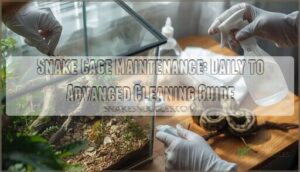This site is supported by our readers. We may earn a commission, at no cost to you, if you purchase through links.
A captive corn snake dies within 72 hours of showing its first symptom—labored breathing that escalates to open-mouth gasping. The necropsy reveals severe bacterial pneumonia, but the pathogen didn’t appear overnight. It had been lurking in the enclosure for weeks, waiting for the right conditions to strike: a temperature gradient that dropped too low during winter, substrate moisture that climbed into the danger zone, and an immune system already compromised by subtle nutritional deficits.
Understanding what causes snake diseases requires looking beyond the immediate pathogen to the intricate relationship of infectious agents, environmental stressors, husbandry failures, and host factors that determine whether your snake thrives or succumbs to illness.
Table Of Contents
- Key Takeaways
- What Causes Snake Diseases?
- How Do Environmental Factors Lead to Disease?
- Which Infectious Agents Affect Snakes?
- How Does Nutrition Influence Snake Disease?
- What Role Do Handling and Hygiene Play?
- Frequently Asked Questions (FAQs)
- What is the cause of snake fungal disease?
- What is the most common cause of death in snakes?
- Which disease is caused by snakes?
- What causes liver disease in snakes?
- What causes reptile diseases?
- What is the origin of snake fungal disease?
- What is snake disease?
- What causes respiratory disease in snakes?
- How do genetic factors influence snake health?
- What role does age play in snake diseases?
- Conclusion
Key Takeaways
- Snake diseases arise from multiple interacting factors—pathogenic microorganisms, environmental stressors, husbandry failures, parasitic infestations, and genetic vulnerabilities—rather than single isolated causes, making prevention dependent on addressing the complete web of risk factors simultaneously.
- Temperature and humidity deviations from species-specific parameters directly suppress immune function, impair digestion, and create conditions for opportunistic bacterial, fungal, and parasitic colonization, with chronic instability elevating cortisol and compromising every physiological defense mechanism.
- Contaminated substrates and poor enclosure hygiene create persistent microbial reservoirs where bacteria like Aeromonas and Pseudomonas, fungal spores from Ophidiomyces, and parasitic eggs continuously reinfect snakes through damaged skin barriers and compromised mucosal surfaces.
- Nutritional deficiencies—particularly inadequate vitamin A, calcium, vitamin D3, and protein—directly weaken immune cell production, antibody synthesis, and epithelial barrier integrity, leaving snakes defenseless against infections that healthy specimens would readily resist.
What Causes Snake Diseases?
Snake diseases don’t emerge from a single source—they’re the result of multiple interacting factors that compromise your snake’s health and defenses. Understanding these underlying causes gives you the power to recognize risk factors before they escalate into serious medical conditions.
Environmental stressors like poor husbandry, temperature fluctuations, and inadequate humidity weaken immunity and create openings for bacterial pathogens that require targeted treatment approaches.
The primary disease triggers fall into five distinct categories: pathogenic microorganisms, parasitic infections, environmental stressors, husbandry failures, and genetic susceptibility.
Pathogenic Microorganisms (Bacteria, Viruses, Fungi)
You’ll encounter bacterial infections, viral outbreaks, and fungal diseases as the primary microbial threats to your snake’s health. Gram-negative bacteria like Aeromonas and Pseudomonas cause septicemia when your snake’s immune system falters, while reptarenaviruses trigger fatal inclusion body disease in boids.
Watch for head tremors, corkscrewing, or stargazing movements, as these are key signs of recognizing snake neurological issues caused by infections.
Ophidiomyces ophiodiicola, the fungal agent behind snake fungal disease, produces severe dermatitis across multiple species, and microbial resistance complicates treatment when pathogens develop antimicrobial tolerance.
Early detection and proper antifungal protocols for snake infections are critical before Ophidiomyces establishes deep tissue invasion or resistance emerges.
Understanding reptile health risks is vital for preventing the spread of diseases in snakes.
Parasitic Infections (Mites, Ticks, Internal Parasites)
Parasitic infections pose significant threats through external mite infestations, tick-borne diseases, and internal parasites that compromise your snake’s physiological integrity. Snake mites like Ophionyssus natricis complete their life cycle in 13 to 19 days, causing:
- Anemia and dehydration from repeated blood feeding
- Secondary bacterial or fungal pathogen entry at attachment sites
- Rapid population growth in warm, humid captive environments
Understanding the snake mite life is essential for effective prevention and treatment.
Intestinal parasites, including Cryptosporidium, helminths, and protozoans, damage mucosal surfaces and impair nutrient absorption, while tick-borne agents like Rickettsia introduce zoonotic transmission risks, requiring vigilant parasite control protocols.
Environmental Stressors (Temperature, Humidity)
Environmental stressors, particularly temperature fluctuations and humidity control, profoundly influence reptile health by disrupting thermoregulation, immune function, and respiratory defense. Maintaining species-specific thermal gradients and relative humidity is crucial for their well-being. Optimal thermal gradients typically range from 75–92°F (24–33°C), while relative humidity requirements vary between 40–90%, depending on the species’ natural habitat.
Calibrated environmental monitoring and climate management are essential to prevent thermal stress, which can suppress appetite, impair shedding, and predispose reptiles to opportunistic infections. Proper reptile husbandry and care are directly linked to disease prevention, highlighting the importance of maintaining precise environmental parameters.
| Environmental Parameter | Optimal Range (Species-Dependent) | Disease Risk When Improper |
|---|---|---|
| Temperature gradient | 75–92°F (24–33°C) | Immune suppression, poor digestion, respiratory disease |
| Relative humidity | 40–90% | Dysecdysis, fungal infections, pneumonia |
| Monitoring frequency | Daily with data logging | Undetected excursions, chronic stress, pathogen colonization |
Poor Husbandry and Hygiene
Temperature and humidity set the stage, but poor husbandry and hygiene practices often deliver the final blow. Overcrowded, unsanitary enclosures dramatically increase pathogen loads, predisposing your snake to respiratory infections, scale rot, and systemic disease. Without routine enclosure cleaning and proper biosecurity measures, bacteria, viruses, and parasites persist in contaminated substrates and water bowls, creating a disease reservoir that continually reinfects your animal.
Alongside sanitation protocols, ensuring your snake receives essential vitamins and minerals for pet snakes helps maintain immune function and resilience against environmental pathogens.
Five critical hygiene practices to safeguard reptile health and wellness:
- Disinfect enclosures weekly with appropriate reptile-safe disinfectants, maintaining contact times of at least 15 minutes to inactivate common pathogens and prevent recurrent infections.
- Remove feces, shed skin, and uneaten prey daily to minimize environmental contamination and reduce the risk of gastrointestinal and zoonotic diseases associated with reptiles.
- Wash hands thoroughly for at least 20 seconds with soap and warm water after snake handling or environmental sanitation to prevent cross-contamination between animals.
- Use dedicated equipment for each enclosure, including separate cleaning tools, feeding tongs, and water dishes, to avoid indirect transmission of infectious agents.
- Quarantine new arrivals for 60–90 days in isolated housing with dedicated supplies, implementing strict biosecurity measures to prevent introduction of pathogens into your collection.
Inadequate reptile care and management, particularly insufficient disinfection protocols and shared equipment use, enables disease transmission within collections. Standing water harbors opportunistic bacteria that cause infectious stomatitis, while excessively damp substrates promote fungal and bacterial dermatitis. Proper disease prevention hinges on consistent environmental sanitation paired with thorough hygiene practices during routine reptile husbandry and care activities.
Choosing between natural vs. artificial substrate for reptiles significantly impacts both sanitation ease and disease prevention strategies in captive environments.
Genetic and Host Factors
Your snake’s genetic blueprint shapes its immune response and disease resistance more than you might expect. Inherited traits determine host immunity strength, influencing susceptibility to bacterial and viral pathogens across different species.
Genetic predisposition affects detoxification pathways and metabolic efficiency, directly impacting reptile health and wellness.
Understanding snake genetics helps veterinary medicine for reptiles advance targeted disease management strategies that account for individual variation in immune response and reptile anatomy and physiology.
How Do Environmental Factors Lead to Disease?
Your snake’s enclosure isn’t just a home—it’s the foundation of its health. When temperature, humidity, cleanliness, or substrate quality falls short, you’re opening the door to respiratory infections, skin diseases, and parasitic infestations that weaken your snake’s immune defenses.
Let’s examine the four environmental factors that most commonly compromise reptile health and predispose captive snakes to disease.
Inadequate Temperature and Humidity
You can’t ignore the thermostat regarding reptile health—inappropriate temperature fluctuations and humidity control failures are direct pathways to disease. When your snake’s habitat drifts outside species-specific parameters, the consequences compound quickly, compromising both respiratory issues and skin shedding cycles while amplifying environmental stress that undermines every aspect of reptile care and maintenance.
- Enclosure temperatures below optimum suppress appetite, impair locomotion, and depress immune function, leaving your snake vulnerable to opportunistic infections
- Relative humidity outside the species-appropriate range creates dermal stress and shedding difficulties, facilitating fungal and bacterial colonization of compromised skin
- Chronic temperature instability elevates cortisol levels, compromising wound healing and overall disease resistance in captive reptiles
- Inadequate thermal gradients lead to moisture retention and impaired ventilation, predisposing snakes to respiratory and integumentary infections
Proper reptile husbandry demands precise environmental parameters—your snake’s immune system, digestive efficiency, and integumentary integrity all depend on stable conditions within the reptile habitat and environment you’ve created.
Dirty or Unsanitary Enclosures
When substrates remain unchanged and feces linger in corners, your snake’s enclosure becomes a microbial reservoir—fecal management isn’t optional in reptile husbandry. Bacterial growth thrives in this neglect, transforming hygiene practices from routine to critical.
Effective sanitation protocols—daily enclosure cleaning, thorough disinfection, substrate replacement—are fundamental to reptile care and maintenance, directly limiting pathogen persistence within the reptile habitat and environment while protecting animal handling safety.
| Pathogen Type | Enclosure Source | Health Risk |
|---|---|---|
| Bacteria (Salmonella, Pseudomonas) | Fecal residue, contaminated water | Septicemia, stomatitis, dermatitis |
| Fungal spores | Moist organic debris, soiled substrate | Ophidiomycosis, reinfection cycles |
| Ectoparasites (mites) | Cracks, crevices, accumulated furnishings | Heavy infestations, cross-contamination |
Chronic Stress From Poor Habitat
When your snake’s enclosure fails to meet spatial or enrichment requirements, you’re not just limiting movement—you’re triggering physiological distress that undermines reptile health and welfare.
Studies on Florida cottonmouths from degraded habitats reveal dampened stress responses, impaired immune markers, and population declines, demonstrating that chronic distress from poor habitat quality disrupts ecological balance, compromises husbandry practices, and directly increases disease vulnerability in captive and wild populations.
Exposure to Contaminated Substrates
You wouldn’t let your child crawl on a floor soaked in waste, yet that’s exactly what happens when your snake rests on dirty bedding—and the health consequences are just as serious.
Dirty substrate exposes your snake to the same health risks you’d never tolerate for a child crawling through waste
Contaminated substrates fuel substrate-borne illness through three deadly mechanisms:
- Bacterial proliferation in moist bedding causes scale rot and septicemia via Aeromonas and Pseudomonas species
- Fungal contamination with Ophidiomyces ophiodiicola persists 30+ days, penetrating skin to cause snake fungal disease
- Parasitic infections from helminth eggs and Ophionyssus mites reinfect snakes through fecal-contaminated surfaces
Ulcerative dermatitis begins where ventral scales contact wet substrates, creating bacterial infections and skin lesions that breach your snake’s first defense.
Substrate hygiene directly determines reptile disease management success—fungal infections and zoonotic diseases like Salmonella multiply sevenfold in enclosures with poor cleaning protocols, making routine substrate replacement your most powerful preventive tool against these substrate-mediated threats.
Which Infectious Agents Affect Snakes?
Your snake’s health can be threatened by a range of infectious agents, each with distinct characteristics and consequences. Bacteria, viruses, fungi, and parasites all pose unique challenges to your reptile’s immune system, and understanding these pathogens helps you recognize disease early and respond appropriately.
Let’s examine the four primary categories of infectious agents that commonly affect captive and wild snakes.
Bacterial Infections (Septicemia, Abscesses)
Bacterial septicemia ranks among the most lethal reptile infections, with Aeromonas and Pseudomonas species frequently isolated from fatal cases. You’ll recognize septicemic shock through respiratory distress, lethargy, and characteristic purplish red spots on your snake’s ventral scales.
Snake abscesses usually develop from penetrating wounds or bacteremia, forming fibrous capsules that resist antibiotic penetration and require surgical drainage for effective reptile disease management.
Viral Diseases (Adenoviruses, Inclusion Body Disease)
While bacteria can often be tackled with aggressive intervention, viral diseases in reptiles present a more challenging clinical picture. Adenovirus strains and Inclusion Body Disease (IBD), linked to reptarenavirus, produce overlapping IBD symptoms—weight loss, lethargy, neurological dysfunction—that complicate disease diagnosis. You won’t find snake vaccines for these pathogens, so viral transmission prevention through quarantine protocols becomes your primary defense against viral infections spreading through your collection.
Three Critical Viral Disease Management Steps:
- Implement strict quarantine: Isolate new arrivals for 90 days minimum to detect asymptomatic carriers before introducing them to established snakes.
- Request PCR testing: Work with your veterinarian to obtain blood or tissue samples for molecular diagnostics when neurological signs appear.
- Maintain dedicated equipment: Use separate feeding tongs, water bowls, and cleaning tools for each enclosure to prevent cross-contamination.
Fungal Infections (Snake Fungal Disease, Dermatophytosis)
Fungal pathogens represent an emerging threat you can’t ignore. Snake Fungal Disease (SFD), caused by Ophidiomyces ophiodiicola, produces characteristic skin infections with raised lesions, facial disfigurement, and secondary bacterial invasion. Culture-based surveillance identified this fungal pathogen in 76 percent of wild snakes with confirmed dermatitis.
Dermatophyte transmission also occurs through Nannizziopsis species, producing granulomatous dermatomycosis in captive collections. Moist substrates and poor ventilation create ideal conditions for Ophidiomyces infection establishment.
Parasitic Infestations (Mites, Ticks, Intestinal Parasites)
Parasitic infestations impose severe disease burdens that must be addressed proactively. Ophionyssus natricis mite infestations can reach approximately 4,000 mites per snake in captivity, causing anemia and irritability through repeated blood feeding. Tick-borne diseases include West Nile virus and Borrelia transmission via Ixodes species. Intestinal parasites—Strongyloides, Capillaria, Cryptosporidium serpentes—produce chronic weight loss and regurgitation when parasite life cycles multiply in contaminated enclosures.
- Ectoparasite control requires environmental treatment beyond topical therapies
- Gastrointestinal nematodes infect 77-88 percent of surveyed captive snakes
- Leeches and ticks transmit bacterial and viral pathogens during prolonged feeding
How Does Nutrition Influence Snake Disease?
Your snake’s diet shapes its immune defenses more powerfully than you might expect, and inadequate nutrition consistently emerges as a silent contributor to disease susceptibility in captive reptiles.
When dietary components fall out of balance—whether through insufficient feeding, excessive prey items, or micronutrient deficits—the body’s protective mechanisms weaken, creating pathways for opportunistic infections and metabolic disorders to take hold.
Understanding these nutritional risk factors will help you recognize how feeding practices directly influence your snake’s resistance to disease.
Malnutrition and Deficiencies
When your snake’s diet lacks essential nutrients, you’re setting the stage for serious health complications. Vitamin deficits—particularly vitamin A—damage respiratory tissue and compromise shedding, while calcium or vitamin D3 shortfalls trigger metabolic bone disease with visible skeletal deformities.
Mineral imbalance and dietary insufficiencies weaken immune defenses, leaving your snake vulnerable to infections. Proper reptile nutrition isn’t optional; it’s your snake’s foundation for disease resistance and longevity.
Overfeeding or Underfeeding
Extremes in feeding schedules directly compromise reptile health, whether you’re offering meals too often or too rarely. Overfeeding triggers obesity, hepatic lipidosis, and gastrointestinal impaction, while underfeeding causes muscle wasting and immunosuppression that leaves your snake defenseless against concurrent illnesses.
Proper meal frequency and weight management—matching prey size to your snake’s age—are essential cornerstones of reptile care and dietary balance.
Vitamin and Mineral Imbalances
Inadequate micronutrient provision disrupts your snake’s skeletal integrity, neurologic function, and epithelial health through vitamin deficiency, mineral disorders, and nutrient toxicity. Calcium imbalance and low vitamin D3 trigger metabolic bone disease in reptiles, while excess vitamin A supplementation damages liver and skin. Thiamine deficiency from fish-only diets causes neurologic signs.
Balanced dietary supplements aligned with reptile nutrition and diet principles safeguard reptile health and care outcomes.
Impact on Immune System
Your snake’s first line of defense crumbles when nutritional deficits compromise immune cell production, antibody synthesis, and inflammatory response capacity, leaving the animal vulnerable to opportunistic pathogens and prolonged infection. Immune system dysfunction increases susceptibility to bacterial infections, infectious stomatitis, and snake fungal disease while reducing pathogen resistance and accelerating cellular damage.
- Protein deficiency impairs lymphocyte proliferation and immunodeficiency factors
- Vitamin A shortage damages mucosal barriers protecting respiratory and digestive tracts
- Selenium and vitamin E insufficiency diminishes inflammatory response control, worsening reptile health outcomes
What Role Do Handling and Hygiene Play?
You can be the strongest link in preventing disease transmission to your snake, or you can be the weakest—it all comes down to how you handle your animal and maintain hygiene around its enclosure. Pathogens don’t respect good intentions, and they spread easily through contaminated hands, shared equipment, and careless cleaning practices that introduce bacteria, fungi, and parasites from one surface to another.
Understanding the specific hygiene protocols that protect your snake requires attention to four critical areas of disease control.
Disease Transmission From Improper Handling
Every time you handle a reptile, you’re standing at the crossroads of zoonotic transmission and public health risk. Improper snake handling acts as a gateway for zoonotic pathogens, especially Salmonella, to leap from animal to human. Fomite spread, cross-contamination, and lapses in biosecurity measures during reptile handling safety routines heighten disease transmission risks.
| Risk Factor | Transmission Pathway |
|---|---|
| Direct Contact | Zoonotic Transmission |
| Shared Equipment | Fomite Spread |
| Poor Hygiene | Cross Contamination |
| Inadequate Protocol | Biosecurity Measures |
Importance of Hand Washing
Washing your hands with soap and warm water for at least 20 seconds stands as the single most effective shield against zoonotic pathogens like Salmonella. This hygiene practice interrupts disease transmission by:
- Removing pathogens from contaminated skin after reptile contact
- Protecting vulnerable populations including children and immunocompromised individuals
- Preventing cross-contamination between enclosures and household surfaces
Soap effectiveness combined with proper water quality ensures public health safety during clean handling protocols.
Use of Dedicated Equipment
Assigning separate tools for each enclosure cuts cross contamination by over 90% when you follow validated cleaning protocols. Dedicated equipment bolsters quarantine protocols by isolating new or ill snakes from your main collection, dramatically reducing bacterial abscesses and fungal infections.
Color-coded or labeled handling tools improve compliance with hygiene practices, ensuring reptile handling safety becomes second nature in your disease prevention strategies.
Preventing Cross-Contamination
Beyond equipment sterilization, rigorous sanitation protocols demand documented monitoring of disinfection contact times and cross-contact events to strengthen disease surveillance.
Quarantine methods gain effectiveness when you track cleaning routines for each enclosure, interrupting the fecal-oral route that spreads adenoviruses and parasitic infections.
These prevention strategies transform hygiene practices from reactive tasks into proactive disease prevention, safeguarding your collection through methodical attention to procedural detail.
Frequently Asked Questions (FAQs)
What is the cause of snake fungal disease?
Ironically, a fungus that thrives in cool, damp hibernacula strikes snakes hardest after winter’s end.
Snake fungal disease originates when the keratinophilic fungus Ophidiomyces ophiodiicola breaches compromised skin, exploiting environmental reservoirs and weakened host immunity.
What is the most common cause of death in snakes?
Septicemia, a bacterial infection affecting the whole body, ranks as the most common cause of death in captive snakes, while vehicle collisions and habitat destruction dominate wild snake mortality.
Which disease is caused by snakes?
When the tables turn, snakes themselves become disease carriers. Snakebite envenoming delivers venom toxicity, causing hemorrhage and paralysis.
Meanwhile, zoonotic infections like reptile salmonellosis and leptospirosis spread through contaminated environments, creating significant public health risks.
What causes liver disease in snakes?
Liver disease in snakes stems from hepatic lipidosis, caused by obesity or anorexia, viral infections like adenovirus, bacterial toxins, mycotoxins, inappropriate husbandry, and metabolic disorders from nutritional imbalances affecting reptile health.
What causes reptile diseases?
Reptile diseases stem from complex interactions between microbial ecology, immune system function, environmental toxins, and reptile genetics—factors that shape disease pathogenesis across species.
Making wildlife disease prevention essential for peak reptile health and longevity.
What is the origin of snake fungal disease?
Snake fungal disease emerged from Ophidiomyces ophiodiicola, a keratinophilic fungus with evolutionary roots in Onygenales.
Genomic evidence suggests recent anthropogenic introductions across continents established environmental reservoirs in snake hibernacula, driving disease emergence through pathogen transmission and variable host susceptibility.
What is snake disease?
You’re looking at any pathological condition that disrupts your snake’s normal function—from infectious diseases like ophidiomycosis and septicemia to parasitic, nutritional, or environmental problems affecting reptile health and animal pathology.
What causes respiratory disease in snakes?
Respiratory infections in snakes stem from bacterial opportunists like Pseudomonas and Klebsiella, viral respiratory pathogens including paramyxoviruses, and snake mites vectoring airborne infections.
Inadequate temperature-humidity conditions compromise tracheal defenses and promote lung lesions.
How do genetic factors influence snake health?
Genetic predisposition shapes immune response variability, and heritable traits like pattern mutations compromise health in some morphs.
Gene expression differences influence inherited resistance to pathogens, including reptarenaviruses and herpesviruses, affecting reptile anatomy.
What role does age play in snake diseases?
Just as humans become more vulnerable with each passing year, your snake’s immune system declines through aging and disease, accelerating susceptibility to infections.
This makes age-related illness a critical factor in reptile health and diseases across snake life stages.
Conclusion
Prevention, persistence, and precision—these principles determine whether your snake survives or succumbs to disease. Understanding what are the causes of snake diseases means recognizing that pathogens don’t act alone; they exploit vulnerabilities created by temperature failures, humidity imbalances, nutritional deficits, and husbandry lapses.
Your vigilance in maintaining ideal environmental parameters, implementing rigorous hygiene protocols, and monitoring subtle behavioral changes transforms captive management from reactive crisis control into proactive disease prevention. The difference between thriving and dying often measures in degrees and days.
- https://www.merckvetmanual.com/all-other-pets/reptiles/disorders-and-diseases-of-reptiles
- https://pmc.ncbi.nlm.nih.gov/articles/PMC12345485/
- https://www.biorxiv.org/content/10.1101/2022.03.25.485740.full
- https://wpvet.com/reptile-rounds/respiratory-infections/
- https://openjournals.ugent.be/vdt/article/75816/galley/199923/view/














